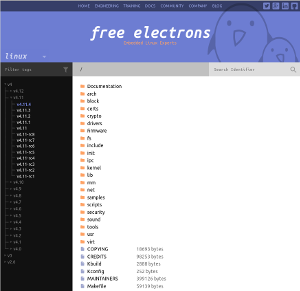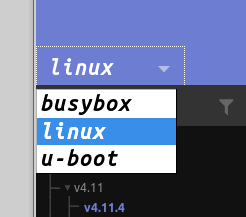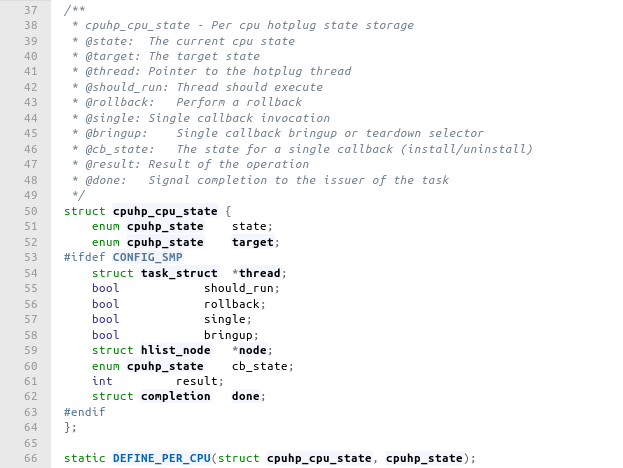Today, we are pleased to announce the initial release of the Elixir Cross-Referencer, or just “Elixir”, for short.
What is Elixir?
 Since 2006, we have provided a Linux source code cross-referencing online tool as a service to the community. The engine behind this website was LXR, a Perl project almost as old as the kernel itself. For the first few years, we used the then-current 0.9.5 version of LXR, but in early 2009 and for various reasons, we reverted to the older 0.3.1 version (from 1999!). In a nutshell, it was simpler and it scaled better.
Since 2006, we have provided a Linux source code cross-referencing online tool as a service to the community. The engine behind this website was LXR, a Perl project almost as old as the kernel itself. For the first few years, we used the then-current 0.9.5 version of LXR, but in early 2009 and for various reasons, we reverted to the older 0.3.1 version (from 1999!). In a nutshell, it was simpler and it scaled better.
Recently, we had the opportunity to spend some time on it, to correct a few bugs and to improve the service. After studying the Perl source code and trying out various cross-referencing engines (among which LXR 2.2 and OpenGrok), we decided to implement our own source code cross-referencing engine in Python.
Why create a new engine?
Our goal was to extend our existing service (support for multiple projects, responsive design, etc.) while keeping it simple and fast. When we tried other cross-referencing engines, we were dissatisfied with their relatively low performance on a large codebase such as Linux. Although we probably could have tweaked the underlying database engine for better performance, we decided it would be simpler to stick to the strategy used in LXR 0.3: get away from the relational database engine and keep plain lists in simple key-value stores.
Another reason that motivated a complete rewrite was that we wanted to provide an up-to-date reference (including the latest revisions) while keeping it immutable, so that external links to the source code wouldn’t get broken in the future. As a direct consequence, we would need to index many different revisions for each project, with potentially a lot of redundant information between them. That’s when we realized we could leverage the data model of Git to deal with this redundancy in an efficient manner, by indexing Git blobs, which are shared between revisions. In order to make sure queries under this strategy would be fast enough, we wrote a proof-of-concept in Python, and thus Elixir was born.
What service does it provide?
First, we tried to minimize disruption to our users by keeping the user interface close to that of our old cross-referencing service. The main improvements are:
- We now support multiple projects. For now, we provide reference for Linux, Busybox and U-Boot.
- Every tag in each project’s git repository is now automatically indexed.
- The design has been modernized and now fits comfortably on smaller screens like tablets.
- The URL scheme has been simplified and extended with support for multiple projects. An HTTP redirector has been set up for backward compatibility.

Among other smaller improvements, it is now possible to copy and paste code directly without line numbers getting in the way.
How does it work?
Elixir is made of two Python scripts: “update” and “query”. The first looks for new tags and new blobs inside a Git repository, parses them and appends the new references to identifiers to a record inside the database. The second uses the database and the Git repository to display annotated source code and identifier references.
The parsing itself is done with Ctags, which provides us with identifier definitions. In order to find the references to these identifiers, Elixir then simply checks each lexical token in the source file against the definition database, and if that word is defined, a new reference is added.
Like in LXR 0.3, the database structure is kept very simple so that queries don’t have much work to do at runtime, thus speeding them up. In particular, we store references to a particular identifier as a simple list, which can be loaded and parsed very fast. The main difference with LXR is that our list includes references from every blob in the project, so we need to restrict it first to only the blobs that are part of the current version. This is done at runtime, simply by computing the intersection of this list with the list of blobs inside the current version.
Finally, we kept the user interface code clearly segregated from the engine itself by making these two modules communicate through a Unix command-line interface. This means that you can run queries directly on the command-line without going through the web interface.

What’s next?
Our current focus is on improving multi-project support. In particular, each project has its own quirky way of using Git tags, which needs to be handled individually.
At the user-interface level, we are evaluating the possibility of having auto-completion and/or fuzzy search of identifier names. Also, we are looking for a way to provide direct line-level access to references even in the case of very common identifiers.
On the performance front, we would like to cut the indexation time by switching to a new database back-end that provides efficient appending to large records. Also, we could make source code queries faster by precomputing the references, which would also allow us to eliminate identifier “bleeding” between versions (the case where an identifier shows up as “defined in 0 files” because it is only defined in another version).
If you think of other ways we could improve our service, don’t hesitate to drop us a feature request or a patch!
Bonus: why call it “Elixir”?
In the spur of the moment, it seemed like a nice pun on the name “LXR”. But in retrospect, we wish to apologize to the Elixir language team and the community at large for unnecessary namespace pollution.
